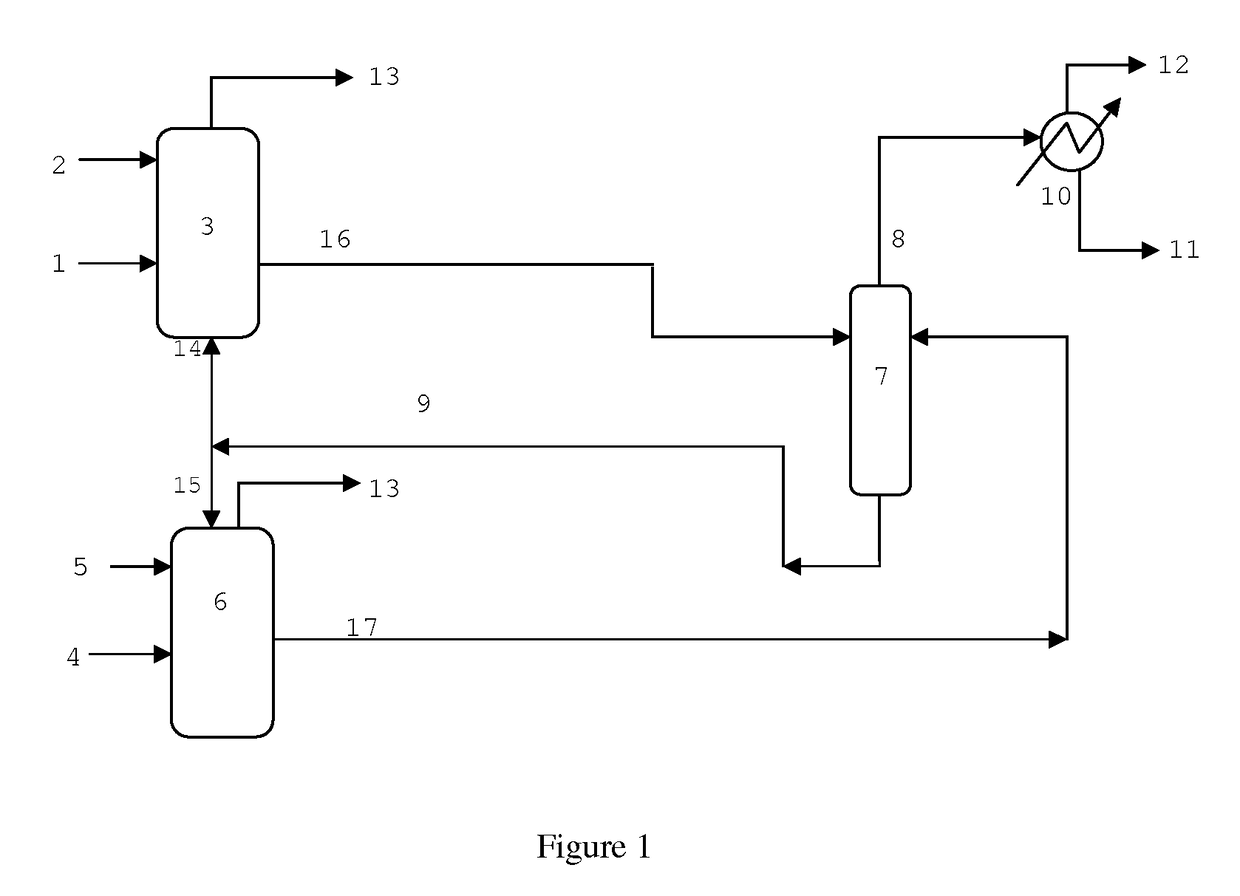Hydroformylation process
a technology of hydroformylation and olefin, which is applied in the direction of organic compounds/hydrides/coordination complexes, physical/chemical process catalysts, organic chemistry, etc., can solve the problems of unstable reactors, affecting reactor stability and catalyst performance, and changing feed compositions, etc., to avoid pitfalls and achieve the effect of capital saving
- Summary
- Abstract
- Description
- Claims
- Application Information
AI Technical Summary
Benefits of technology
Problems solved by technology
Method used
Image
Examples
example 1
[0142]ASPEN Plus Dynamics™ process simulation software is used to develop an Oxo reaction system process control model for the process of FIG. 1. The catalyst is a typical Rh-bisphosphite catalyst as described in U.S. Pat. No. 4,668,651 and the reaction conditions are essentially those of Example 5 of that patent for butene-1 and Example 9 of that patent for propylene except for the following: a raffinate stream is employed rather than butene-1, the initial target rhodium concentration for the propylene train is 72 ppm Rh, and for the raffinate train the rhodium concentration design target is 260 ppm rhodium, with a Ligand:Rh ratio of >1 for both trains. These are efficient levels that would be used in conventional plants having two completely separate trains, giving high reaction rates, high conversions, and low ligand consumption at design rates for each train.
[0143]The basis for the modeling the reactor control system is as follows:[0144]1) The Oxo reaction rate is directly propo...
example 2
[0151]A series of ASPEN Plus Dynamics™ process simulations are performed using the process of Example 1 to demonstrate the effect of process disturbances on reactor behavior typically observed in commercial operation. These involve reductions in one feed or the other.
The sequence of process feed disturbances is as follows:
[0152]Initially, Propylene and raffinate feed flow rates are at design flow rates.[0153]At time 4 hours, the raffinate feed flow rate begins a reduction to half of the design flow over a 6 hour ramp period.[0154]At time 10 hours, the raffinate feed flow is maintained at 50% of design rates.[0155]At time 40 hours, the raffinate feed flow rate begins a 6 hour increase returning to design rates.[0156]At time 46 hours, the raffinate is maintained at design flow rates.[0157]At time 75 hours, propylene feed flow rate begins a ramp for 50% reduction that takes 10 hours.[0158]At time 85 hours, the propylene feed is maintained at 50% of design flow rate.[0159]At Time 103 ho...
example 3
Example 2 is repeated except that a different control scheme is employed, as follows:
[0163]Maintain the propylene reactors, Reactor (3), at constant temperature and vary the catalyst recycle mass flow rate (stream (14)) to achieve the desired rhodium concentration. The purpose of the control scheme is to maintain the propylene reactors, Reactor (3), at constant reactivity and vary the catalyst recycle mass flow rate (stream (14)) to achieve the desired rhodium concentration. The approach is to “infer” the Reactor (3) rhodium concentration based on the overall material balance and physical volume and geometry of the Oxo reaction system from which the control change is determined. Since the total rhodium inventory is known and fixed, the effect of changes in the operation of each reactor train can be used to predict the performance. The primary variable for each reaction train is the olefin feed, propylene and raffinate for reactors (3) and (6), respectively.
[0164]The control scheme c...
PUM
| Property | Measurement | Unit |
|---|---|---|
| temperatures | aaaaa | aaaaa |
| temperatures | aaaaa | aaaaa |
| temperatures | aaaaa | aaaaa |
Abstract
Description
Claims
Application Information
 Login to View More
Login to View More - R&D
- Intellectual Property
- Life Sciences
- Materials
- Tech Scout
- Unparalleled Data Quality
- Higher Quality Content
- 60% Fewer Hallucinations
Browse by: Latest US Patents, China's latest patents, Technical Efficacy Thesaurus, Application Domain, Technology Topic, Popular Technical Reports.
© 2025 PatSnap. All rights reserved.Legal|Privacy policy|Modern Slavery Act Transparency Statement|Sitemap|About US| Contact US: help@patsnap.com



